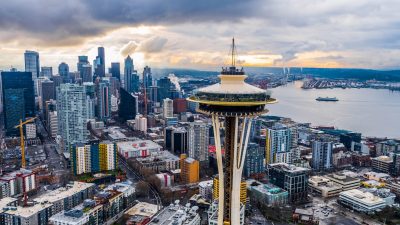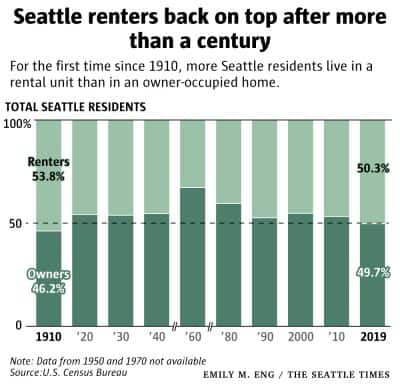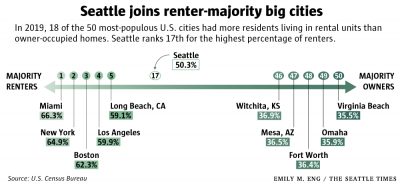For the first time in 100 years, Seattle renters outnumber homeowners
 The last time there were more renters than homeowners in Seattle, Pike Place Market (est. 1907) was a new thing.
The last time there were more renters than homeowners in Seattle, Pike Place Market (est. 1907) was a new thing.
Census data shows that in 1910, there were about 15,000 more Seattle residents living in a rental than in an owned home. But by 1920, owners had moved into the majority, and it remained that way for a century.
Until now, that is.
In 2019, the estimated renter population in Seattle was roughly 366,000, according to census data — just slightly larger than the estimated homeowner population, which was about 362,000.
Granted, these figures are estimates, with a margin of error built in. Even so, it’s been clear from census data that Seattle has been gradually moving toward renter-majority status in recent years. It was only a matter of time before we got there.
In fact, the peak year of homeownership in Seattle is long behind us. That happened in 1960, at a time when Boeing, not Amazon, was the engine behind the city’s boom.
As Seattle grew rapidly in the postwar period, most of the population growth was absorbed by the neighborhoods made up of single-family homes. To this day, the majority of city residential land is zoned for single-family homes (which is a source of constant frustration to our many local urbanists).
Census data shows that in 1960, about 364,000 Seattle residents (67%) lived in owner-occupied homes — interestingly, that’s almost the exact same number as today. But the number of people living in rentals at that time was not even half as large, at only about 178,000.
Part of the reason the population in owner-occupied homes was so much larger was because of household size. Families with children were more likely to live in an owned home, while single people were more likely to live in a rental unit. That’s still true today. But in 1960, the baby boom was in full swing, and Seattle had a lot more children than it does now.
By the 1970s, the Boeing boom had given way to the Boeing bust, and Seattle’s population was shrinking. The number of people living in owned homes also declined, and it only began to rebound after 1990. On the other hand, the number of people living in rental units has had much steadier growth over those decades (despite a slight drop between 1990 and 2000).
There are a variety of reasons people rent rather than own, but one of the major ones is cost. Home prices in Seattle have long been higher than the national average, but in the last decade, they’ve soared out of reach even for many who have good incomes. The typical Seattle home had a value of $804,500 in November, according to real estate data firm Zillow.
And that surely has a lot to do with why, since 2010, Seattle’s renter population has grown at twice the rate as the owner population — a 34% vs. 17% rate of increase.
Among the 50 most-populous U.S. cities, Seattle is now among just 18 in which the estimated renter population is larger than that of owners.
The most renter-dominated major city is Miami, with 66% of its residents living in an apartment or other rental unit. New York is No. 2 at 65%, followed by Boston, at 62%.
The most owner-dominated major city is Virginia Beach, where around 65% of the population lives in a home that is owned. Omaha and Fort Worth are right behind, in that order.
A note on the data: The figures used in this column are for people who live in rented or owned households. Some people live in what the Census Bureau calls “group quarters” — nursing homes, dormitories, military barracks, prisons, shelters and other institutionalized settings. People who live in group quarters are considered neither renters nor homeowners. In Seattle, about 26,000 people — 3.5% of the population — live in group quarters.
Source: seattletimes.com

















 Accessibility
Accessibility